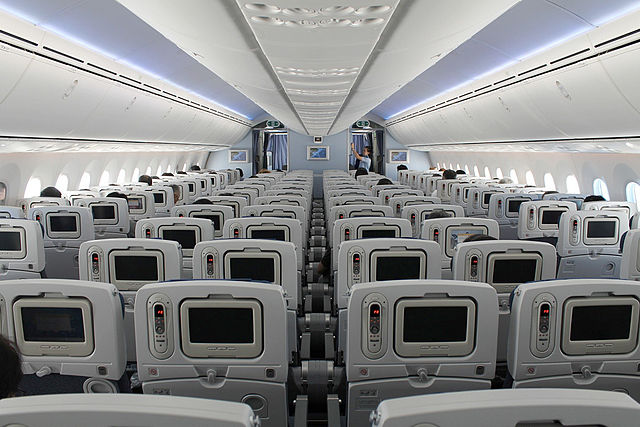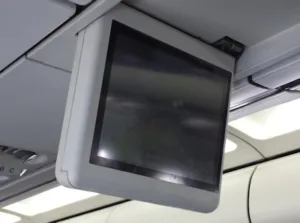I’m writing today’s Display Daily on an aeroplane as I fly to a press event put on by Sharp. The event is in Malta – a pleasant place to be for such an event, but also meaning some hours in transit. The journey got me thinking about the displays on the plane. The Airbus A319 from Air Malta that I was on uses drop down 10″ or so LCDs every three rows and on the flight they were showing the route map.

All the drop down displays are quite dim, but the one nearest to me, and just above the seat one across and to the front of me, is clearly a TN panel, without wide angle viewing film and is completely useless (see picture). I only know what is being shown by looking at the row several ahead, and on that screen, the performance is so short of contrast that if I didn’t already know many of the names of the places on the screen, I would be unable to get anything from it. (strangely, the apparently similar display on the movable divider between business and economy class has quite a bright and contrasty display)
The reality is that the displays on our personal devices are much better than those provided by airlines, especially in anything except the most recent planes. Aircraft builders, like auto makers, have very different lifetime, warranty and approval issues to mobile device makers, of course.
Airlines are obsessed with weight. I recently heard the statistic at an SES event in Amsterdam before IBC, that a single cube of sugar carried on a flight all year, costs the airline $500 per year in additional fuel costs. (See comments below this article for a refutation of this! Man. Ed.)
(At the event, Ferdinand Kayser, the CEO of SES mentioned, in commenting on the business for satellite operators that can provide in flight connectivity, that recent research by a US airline showed that the most used website on flights with broadband connectivity is Amazon.com. People like shopping on board, so it would make much more sense to make it easier for passengers to shop using Wi-fi on the plane, and keep the duty free goods at the destination airport, where they could be prepared for collection – airlines could also have a much wider product offering. International regulations on duty-free sales would, no doubt, have to be modified and that could be a significant barrier to the change.)
Given the obsession with space and weight, it might have seemed that aircraft would be an early and natural place for OLED technology, which has clear advantages over LCD in these areas (as well as viewing angles, which would have helped me). However, lifetime issues are inevitably a huge question for new display technologies, especially OLED.
We reported in 2008 on expectations that OLED would soon come into aviation and a dig back into our database shows a front page interview with David Fyfe of Cambridge Display Technology, who identified aviation displays as a key application for a second OLED production line. That was in 2000, when CDT was setting up its first pilot production. Rockwell Collins, which makes a lot of aviation displays, said in 2013 that it might see some OLEDs by 2016.
I was trying to remember if I have seen a single press announcement for an OLED display in an aviation application, other than in a near-to-eye microdisplay from eMagin. Tablets are also used in aviation and some of those have OLEDs, of course. But I couldn’t find another example. If you have a story of a win, let me know!
 Boeing 787 8 Dreamliner All Nippon Airways – Source:WikipediaOnce a technology is stable, airlines can adopt it – for example, Diehl Aerospace of Germany is said to be the global leader in cabin lighting for airliners and has supplied all LED cabins for the Boeing 787 Dreamliner and the Airbus A350 XWB.
Boeing 787 8 Dreamliner All Nippon Airways – Source:WikipediaOnce a technology is stable, airlines can adopt it – for example, Diehl Aerospace of Germany is said to be the global leader in cabin lighting for airliners and has supplied all LED cabins for the Boeing 787 Dreamliner and the Airbus A350 XWB.
OLED lighting would seem a natural fit for the curved shapes and flat areas of aircraft cabins and we reported on a project last year that is backed by the EU and includes Osram as well as Diehl, to develop flexible OLED-based lighting. (Fraunhofer Investigates Flexible Lighting)
Flexible and roll-out displays might also be an interesting development in aircraft cabins and some aircraft makers are developing fuselages without windows – replacing the windows with flat displays. That might be the perfect application for the flexible & magnetic OLED display that LG has been showing, most recently at its IFA press event.- BR
 LG Flexible OLED shown at the IFA press event – just what you might need to put on the inside of an airliner without windows. Photo Source: Meko Bob Raikes.
LG Flexible OLED shown at the IFA press event – just what you might need to put on the inside of an airliner without windows. Photo Source: Meko Bob Raikes.

